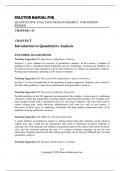Exam (elaborations)
Solution Manual for Quantitative Analysis for Management, 14th edition by Barry Render, Ralph M. Stair Jr, Michael E. Hanna, Trevor S. Hale-Test Bank
Solution Manual for Quantitative Analysis for Management, 14th edition by Barry Render, Ralph M. Stair Jr, Michael E. Hanna, Trevor S. Hale. Table of Contents: Introduction to Quantitative Analysis Probability Concepts and Applications Decision Analysis Regression Models Forecasting Inventory Contr...
[Show more]



